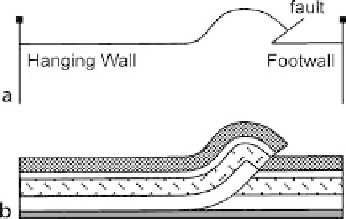Geology Reference
In-Depth Information
flexural-slip model. Simple shear is the geometry produced by slip on closely spaced,
parallel planes with no length or thickness changes parallel or perpendicular to the
slip planes. Simple shear parallel to bedding is the mechanism of flexural slip. Simple
shear oblique to bedding (Fig. 11.3c) is a kinematic model that causes bed length and
bed thickness changes. Pure shear is an area-constant shape change (Fig. 11.3d) for
which the shortening in one direction is exactly balanced by extension at right angles
to it. Restorations are produced by applying one or more of these kinematic models to
the deformed-state structure to return it to its pre-deformation configuration.
A valid map or cross section may be restorable by more than one kinematic model,
and different models will produce somewhat different restored geometries. It follows
that any given restoration does not necessarily represent the exact pre-deformation
geometry or the specific path followed by the structural evolution. Nevertheless, the
internal consistency of the restoration by any technique constitutes a validation of
the interpretation. If a restoration is possible, it shows that the structure is internally
consistent even if the restoration technique is not a perfect model for the deformation
process.
Kinematic models contain the relationships needed to predict the geometry and
evolution of a structure. The predictive capabilities of the models are the basis of tech-
niques for utilizing very limited amounts of information to predict the geometry in
areas of very sparse data or no data (Fig. 11.4). This chapter introduces the basic ki-
nematic models and their predictive capabilities.
Kinematic models represent simplified descriptions of the mechanical processes
that form structures. The deformation in some structures is more complex than can be
fit by one of the simple kinematic models. For these structures the more general area-
balancing methods can be appropriate. Using the relationship between displaced area
and depth, a structure can be tested for area balance and its lower detachment pre-
dicted without performing a restoration or a model-based prediction. Layer-parallel
strain is treated here because it is an intrinsic part of both the kinematic models and
the area-depth relationship and because it provides a tool for predicting sub-resolu-
tion structure (i.e., folds and faults too small to be seen at the resolution of the data)
and is another tool for validating the structural interpretation.
The chapter begins with the most general concepts, an overview of balance and
restoration followed by a discussion of strain and strain partitioning. Then the model-
independent area-balance methods and area-depth technique are given, followed by
the individual kinematic-model-based restoration and prediction techniques.
Fig. 11.4.
Prediction of fault shape from
geometry of a key bed using
the flexural-slip kinematic
model (after Geiser et al. 1988).
a
Key bed required for pre-
diction.
b
Predicted complete
hangingwall geometry and
fault shape

